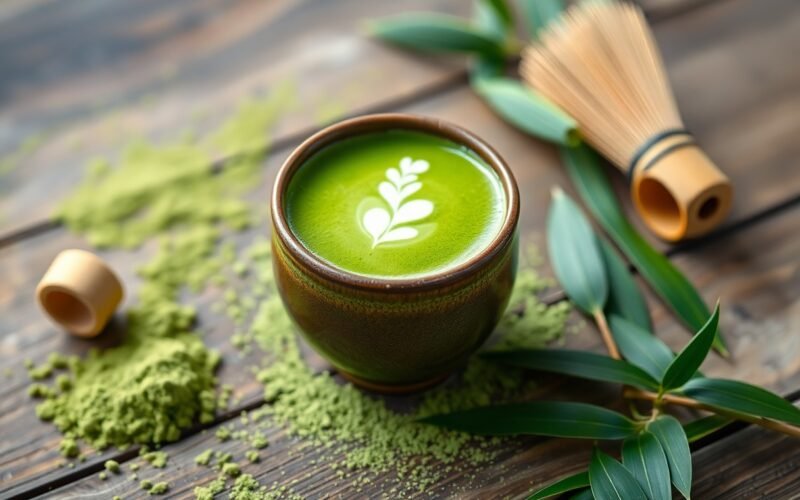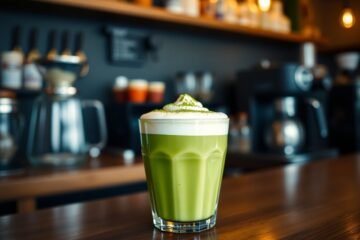Matcha has emerged as a beloved superfood, captivating your taste buds and health-conscious lifestyle alike. This vibrant green powder, derived from finely ground green tea leaves, offers exceptional health benefits, including boosting your energy, enhancing focus, and providing a rich source of antioxidants. You may find that incorporating matcha into your daily routine not only elevates your beverage game but also supports your overall well-being. As you explore why matcha has taken the wellness world by storm, you’ll discover its unique flavor profile and impressive nutritional value that make it a favorite among health enthusiasts.
Key Takeaways:
- Matcha is rich in antioxidants, specifically catechins, which may contribute to improved health benefits such as enhanced metabolism and reduced risk of chronic diseases.
- The drink offers a unique combination of caffeine and L-theanine that can provide sustained energy and mental clarity without the jitters commonly associated with coffee.
- Matcha’s versatility in culinary applications—from lattes to smoothies and desserts—contributes to its popularity and makes it an appealing choice for various dietary preferences.
The Origins of Matcha: More Than Just a Trend
With its root deeply embedded in centuries of tradition, matcha isn’t merely a passing fad. Originating from China during the Tang Dynasty, it was later refined and embraced by Japanese tea culture, where it still holds significant cultural value today. The preparation of matcha involves grinding shade-grown tea leaves into a fine powder, allowing you to enjoy its rich flavor and numerous health benefits in each vibrant cup. As you savor the earthy notes, you also partake in a ritual that has been cherished for generations.
Historical Significance in Japanese Culture
In Japan, matcha has been integral to various ceremonies, most notably the traditional tea ceremony known as “chanoyu.” This practice emphasizes mindfulness and appreciation—elements that enhance your overall experience and connection to the moment. The tea is often served with sweet confections, reflecting a harmony of taste deeply rooted in aesthetic and cultural significance. In essence, enjoying matcha goes beyond just flavor; you engage in a cultural exchange, embodying ideals of peace and tranquility celebrated since the 12th century.
Traditional Production Methods and Their Impact on Quality
The quality of matcha is intricately linked to its production methods, which have remained largely unchanged for centuries. After being shaded for weeks to enhance chlorophyll levels, the leaves undergo meticulous harvesting and processing. Only the finest young leaves are selected, steamed to halt oxidation, and dried before grinding in granite stone mills. This labor-intensive procedure can take up to one hour to produce just 30 grams of matcha, ensuring a product that’s rich in antioxidants and flavor. Such dedication to quality guarantees that when you enjoy matcha, you’re experiencing both a flavorful beverage and a testament to traditional craftsmanship.
Unpacking the Health Benefits: Why Nutritionists Are All In
Nutritionists praise matcha for its impressive health benefits, making it a top choice among superfoods. Rich in antioxidants, particularly catechins, matcha enhances your wellness while safeguarding against various health issues. As nutritionists investigate deeper into the science behind matcha’s health benefits, many have embraced it, citing studies and evidence. For more insights, you can explore Why is Everyone Obsessed with Matcha Now?.
Antioxidants and Their Role in Wellness
The high concentration of antioxidants in matcha, especially epigallocatechin gallate (EGCG), plays a significant role in promoting wellness. These potent compounds combat oxidative stress, reducing the risks of chronic conditions such as heart disease and diabetes. By drinking matcha, you enhance your body’s defenses against harmful free radicals, supporting a healthier and more vibrant life.
Effects on Energy Levels and Mental Clarity
Matcha is celebrated for its unique combination of caffeine and L-theanine, which can significantly enhance your energy levels and mental clarity. Unlike regular coffee, the gradual release of caffeine in matcha provides a more sustained energy boost, preventing the jitters associated with traditional caffeinated beverages. This harmonious blend helps you stay focused and alert throughout the day.
The L-theanine in matcha promotes relaxation without drowsiness, making it easier to achieve a peaceful state of mind while remaining productive. Studies show that this synergistic effect can improve cognitive function, memory retention, and overall mental performance, making matcha an ideal beverage for anyone looking to supercharge their daily routine. By incorporating matcha into your diet, you can effectively elevate both focus and energy, allowing you to tackle tasks with newfound clarity and motivation.

Matcha vs. Traditional Green Tea: What Sets It Apart?
Matcha distinguishes itself from traditional green tea primarily through its cultivation, preparation, and consumption methods. While traditional green tea leaves are steeped in hot water, matcha involves grinding whole tea leaves into a fine powder, which you whisk into hot water or milk. This process not only enhances the flavor but also allows you to consume the entire leaf, leading to a more concentrated experience of nutrients and benefits.
Nutritional Comparison of Matcha and Green Tea
Nutritional Content Comparison
| Component | Matcha | Traditional Green Tea |
|---|---|---|
| Caffeine | 70 mg (per serving) | 30 mg (per serving) |
| Antioxidants | ORAC 1,500 | ORAC 1,200 |
| L-Theanine | 35 mg | 15 mg |
| Chlorophyll | High | Moderate |
Flavor Profiles: A Taste of the Extraordinary
You’ll find that matcha boasts a rich, complex flavor profile that elevates your tea-drinking experience. It offers a smooth, creamy texture with grassy notes and a subtle sweetness, making it versatile for everything from lattes to desserts. Traditional green tea, while refreshing, presents a more muted flavor, often described as vegetal or mildly astringent. The unique umami flavor of high-quality matcha is often what enchants tea enthusiasts and food lovers alike, giving it that extraordinary appeal.
The dynamic taste of matcha is attributed to its specific growing conditions, where shade-grown leaves develop an intense richness. Many connoisseurs prefer high-grade ceremonial matcha for its naturally sweet and vibrant flavor, which contrasts sharply with the more straightforward taste of traditional green tea. When you whisk matcha into hot water, the frothy layer that forms enhances the overall sensory experience. Whether sipped plain or blended into your favorite recipes, matcha stands out as a superbly captivating choice for tea lovers seeking a deeper flavor adventure.
The Rise of Matcha in Modern Cuisine and Lifestyle
You might have noticed how matcha has crept into every corner of modern gastronomy. Its vibrant green hue and robust flavor appeal to health-conscious individuals and culinary creatives alike. Chefs are incorporating matcha into everything from savory dishes to artisanal chocolates, making it a staple in gourmet cuisine. The ingredient has climbed the culinary ladder, shifting from traditional Japanese tea ceremonies to trendy restaurants and health food stores around the world. To understand its meteoric rise, you can explore the article on Why is matcha suddenly in everything?
Matcha in Café Culture: From Beverages to Desserts
In the café scene, matcha has transformed the way you enjoy your afternoon pick-me-up. You can now sip on matcha lattes, enjoy cold brew variations, or indulge in matcha-infused pastries. This green powerhouse offers a unique twist to traditional beverages, appealing to both seasoned matcha drinkers and newcomers alike. With Instagram-worthy presentations and rich health benefits, cafes are expertly catering to your cravings while promoting a cooler, more colorful beverage culture.
Marketing Strategies Driving Popularity Among Millennials
Millennials have found their niche in the matcha boom, driven largely by effective marketing tactics. Brands are harnessing the power of social media to create visually captivating content that showcases the vibrant aesthetics of matcha-based products. Influencer partnerships amplify this effect, as trendsetters resonate with their followers on platforms like Instagram and TikTok. The buzz around matcha as a sustainable and health-conscious choice creates a strong connection with young consumers who prioritize their wellness and environmentally-friendly practices.
With 76% of millennials interested in health-focused food options, matcha has perfectly aligned with their values and eating habits. Brands craft narratives around matcha’s origins, focusing on its rich, cultural heritage and benefits, thereby enhancing emotional engagement with this demographic. Furthermore, carefully designed packaging and approachable recipes invite you to experiment in your own kitchen, fostering a sense of community. The combination of cultural significance and irresistible marketing makes matcha not just a drink, but a lifestyle choice that resonates deeply with a generation seeking both flavor and purpose.
The Environmental and Economic Impact of Matcha Farming
Matcha farming carries both environmental benefits and challenges that affect global ecosystems and economies. Traditional cultivation methods promote sustainable agricultural practices, encouraging biodiversity and soil conservation. However, the rapid rise in demand leads to increased pressure on resources, often resulting in deforestation and water shortages in some regions. As matcha enthusiasts, understanding these impacts can help you make informed choices, potentially supporting farms that prioritize sustainable practices. To dive deeper into the buzz, check out the discussion on Why are they so obsessed with matcha? : r/KUWTK.
Sustainable Practices in Matcha Cultivation
Many matcha producers are now adopting sustainable farming techniques that minimize the use of chemical fertilizers and pesticides. These practices include shade-grown cultivation where tea plants are covered during their growth cycle, which helps in reducing water consumption and promoting high-quality leaf production. By choosing matcha brands committed to sustainable methods, you actively contribute to environmental conservation efforts.
The Global Market: Growth Trends and Challenges
The global matcha market is projected to grow at a significant pace, fueled by increasing consumer awareness of health benefits and expanding culinary uses. Nevertheless, challenges arise as farmers face competition, fluctuating prices, and potential overharvesting. Mitigating these issues requires dedication from producers to balance demand and maintain eco-friendly practices while you, as a consumer, support those who prioritize quality and sustainability.
The matcha market’s growth trends show a remarkable CAGR of around 7.3% from 2020 to 2027. As demand surges, producers must navigate issues such as climate change, which can affect traditional growing regions, and ensure proper supply chain practices to sustain quality. Global competition and shifting consumer preferences also necessitate innovation in processing and product offerings, prompting smaller farms to adapt quickly or risk being overshadowed by larger brands. Your choices can influence these dynamics, as prioritizing authentically sourced matcha can help small producers thrive amid these challenges.
Final Words
With these considerations in mind, it’s clear why matcha has gained immense popularity as a superfood drink. You benefit from its unique blend of antioxidants, sustained energy, and potential health perks, making it an appealing choice for your daily routine. Its versatility allows for various culinary experiments, adding a flavorful twist to your beverages and dishes. As you explore matcha, you’ll likely discover why it resonates with your wellness goals and lifestyle.
Q: What are the health benefits of matcha that have contributed to its popularity?
A: Matcha is rich in antioxidants, particularly catechins, which are known for their health-boosting properties. It is believed to enhance metabolism, improve mental clarity, support heart health, and promote relaxation due to the presence of L-theanine, an amino acid that induces calm without drowsiness. Furthermore, matcha contains a higher concentration of chlorophyll, which is thought to help detoxify the body. These numerous health benefits have led many individuals to embrace matcha as part of a healthier lifestyle.
Q: How does matcha compare to regular green tea?
A: While both matcha and regular green tea come from the Camellia sinensis plant, matcha is made from high-quality tea leaves that are ground into a fine powder, allowing the consumer to ingest the whole leaf and benefit from all its nutrients. This results in matcha typically containing higher levels of antioxidants, caffeine, and L-theanine compared to standard green tea. Additionally, matcha’s unique preparation and consumption method – whisking the powder into hot water – offers a more rich and robust flavor experience.
Q: Why has the preparation and enjoyment of matcha become increasingly popular in recent times?
A: The rise of matcha can be attributed to several factors, including the growth of health-conscious consumer trends and the popularity of café culture that promotes unique beverage experiences. Social media platforms have played a significant role, as visually appealing matcha lattes and desserts have inspired many to experiment with matcha in various recipes. Additionally, the versatility of matcha has captivated culinary enthusiasts, leading to its incorporation in a range of products from smoothies to baked goods, thus increasing its visibility and demand.




